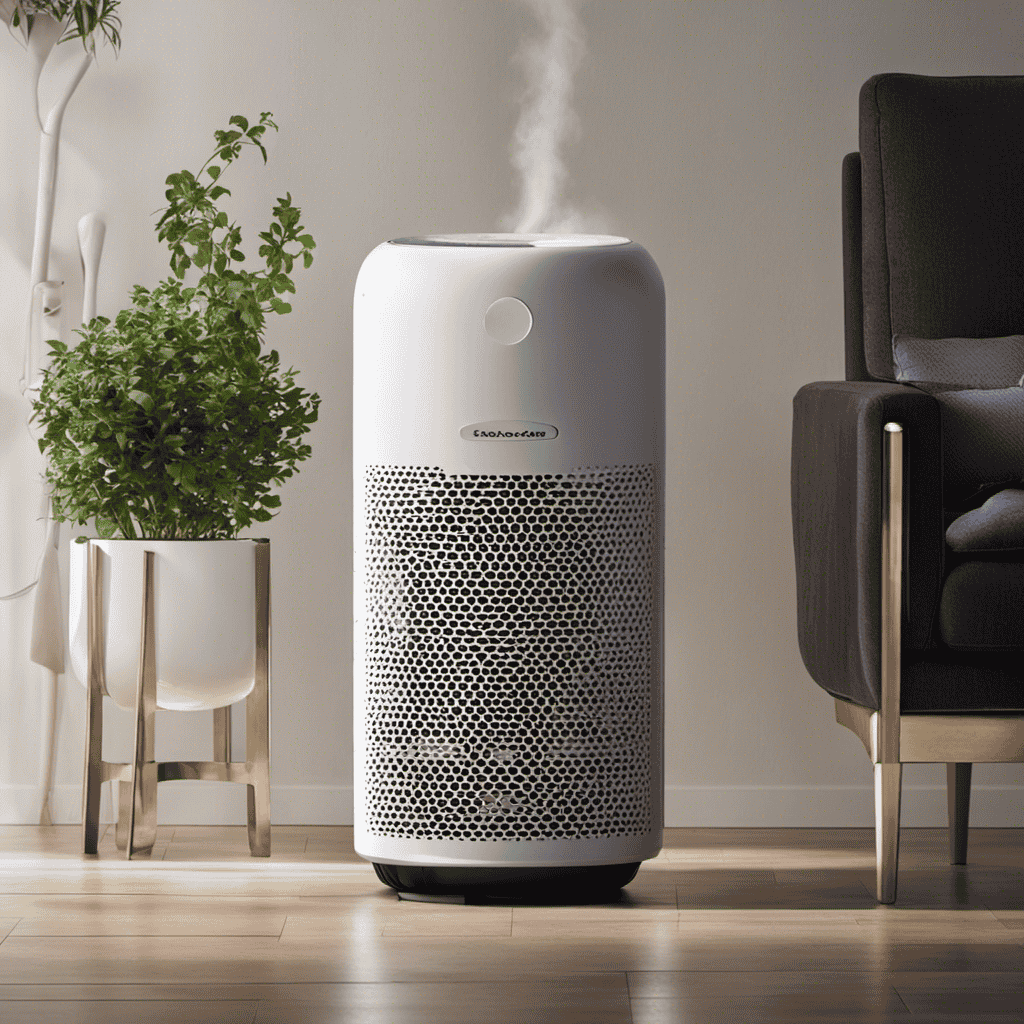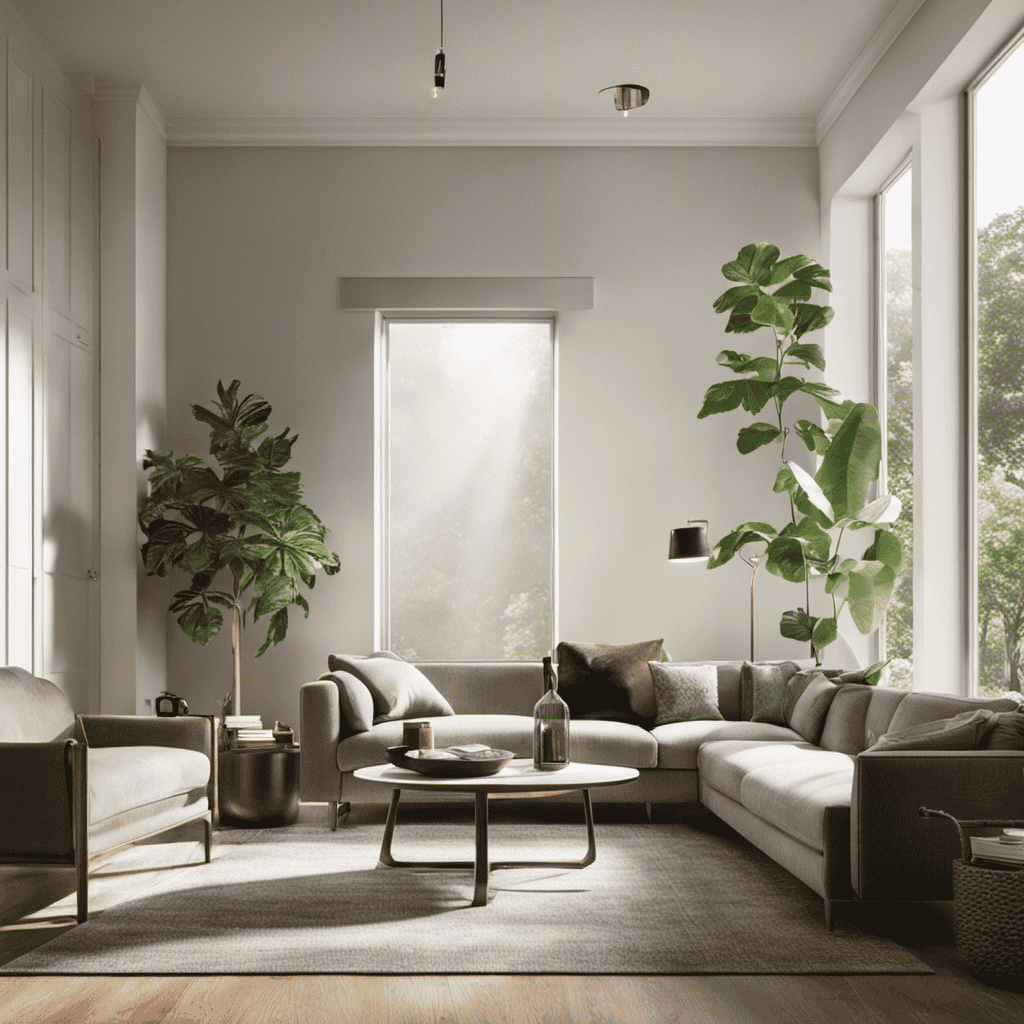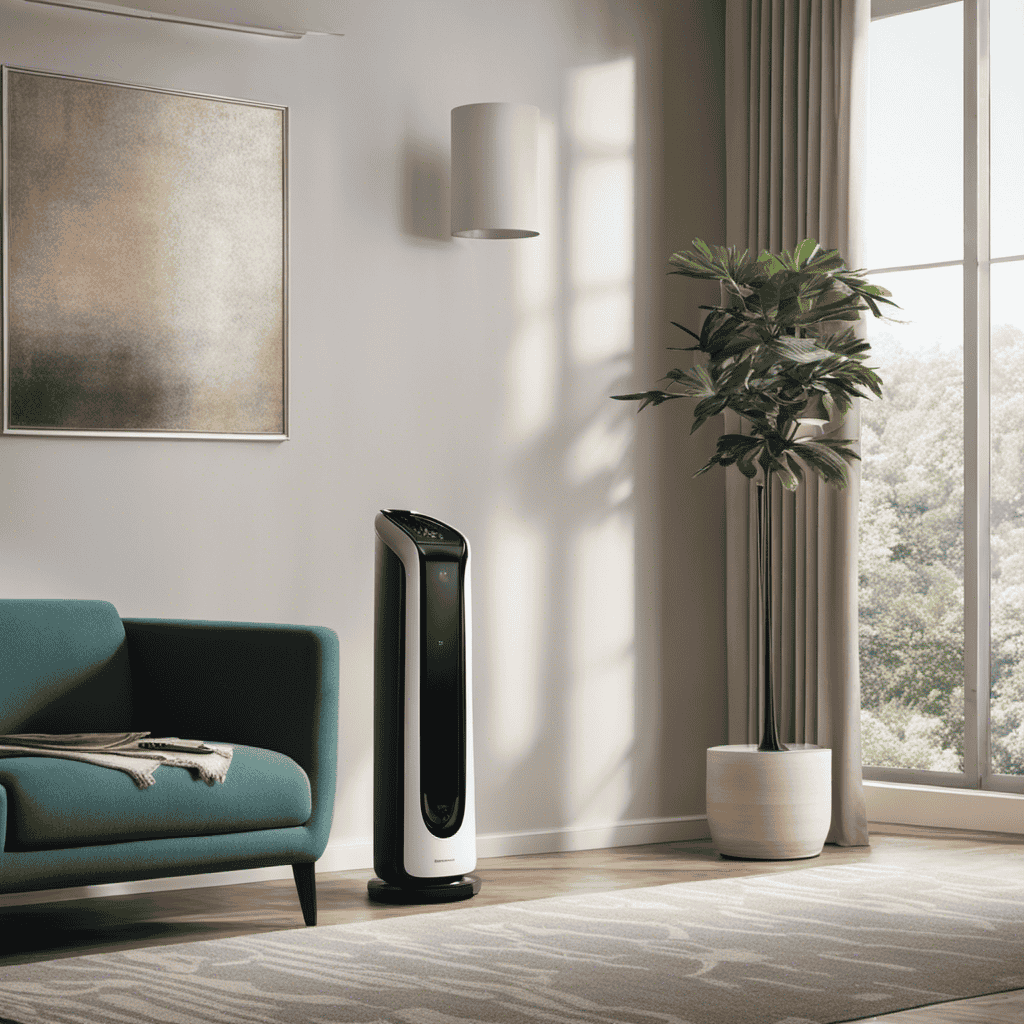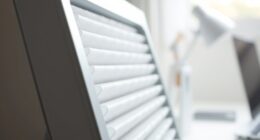As a owner of an air purifier, I have frequently asked myself, “Why does my air purifier have a smell?” It can be disappointing to spend money on a device intended to enhance the air quality in my home, only to encounter unpleasant odors.
In this article, we’ll explore the common reasons behind these smells and delve into the hidden culprits like mold and pet dander. We’ll also discuss troubleshooting tips and the benefits of regular cleaning to ensure our air purifiers are working at their best.
Let’s uncover the secrets to a fresh and clean environment!
Key Takeaways
- Lack of regular cleaning and maintenance can cause odors in air purifiers.
- Mold and mildew growth can contribute to lingering odors in air purifiers.
- Pet dander and allergens can be a source of unpleasant smells in air purifiers.
- Chemicals and VOCs present in household items can emit strong odors that can be captured by air purifiers.
The Importance of Clean Air in Your Home
You need to understand the importance of having clean air in your home.
Indoor air quality plays a crucial role in our overall health and well-being. Breathing in clean air can have numerous health benefits, including reducing the risk of respiratory problems, allergies, and asthma.
When the air in our homes is polluted with dust, allergens, and toxins, it can lead to various health issues, such as coughing, sneezing, headaches, and fatigue.
By ensuring that the air in our homes is clean and free from pollutants, we can improve our respiratory function, sleep quality, and overall quality of life.
Investing in air purifiers, proper ventilation, and regular cleaning can greatly contribute to maintaining clean and healthy indoor air.
Common Reasons for Odors in Air Purifiers
One common reason for odors in air purifiers is that they aren’t being cleaned regularly. Proper air purifier maintenance is crucial for keeping the device running efficiently and effectively. Over time, dust, dirt, and other particles can accumulate in the filters, causing them to become clogged and reducing their ability to remove odors from the air.
Regularly cleaning or replacing the filters is essential to maintain optimal performance. Additionally, the interior components of the air purifier, such as the fan and motor, can also collect dirt and debris, leading to unpleasant odors. Cleaning these components regularly can help eliminate any lingering smells.
Mold and Mildew: A Hidden Culprit
Mold and mildew can be a hidden culprit behind lingering odors in air purifiers. These microscopic organisms thrive in damp environments and can easily find their way into the filters and vents of your air purifier. If not properly addressed, they can lead to a host of problems, including foul smells and potential health risks.
Mold prevention is crucial to maintaining a clean and odor-free air purifier. Regularly cleaning and replacing filters, as well as keeping your air purifier in a well-ventilated area, can help prevent the growth of mold and mildew.
It is important to be aware of the hidden dangers that mold and mildew can pose, as they can not only cause unpleasant odors but also contribute to respiratory issues and allergies. By taking proactive steps to prevent mold and mildew growth, you can ensure that your air purifier remains effective and odor-free.
Pet Dander and Odor Control
To effectively control pet dander and odor, regularly grooming your furry friends and keeping them off furniture can make a significant difference. As a pet owner, I understand the challenges of dealing with pet hair and allergens. Here are some tips that have helped me in my quest for a clean and fresh-smelling home:
- Brush your pets regularly to reduce shedding and control pet hair.
- Vacuum your home frequently, paying special attention to areas where your pets spend the most time.
- Wash pet bedding and blankets regularly to remove dander and odors.
- Use a high-quality air purifier with a HEPA filter to capture pet allergens and eliminate odors.
- Consider using pet-friendly cleaning products to minimize chemical irritants.
With these strategies in place, you can create a healthier environment for both you and your furry friends.
Now, let’s explore the next section about dust and allergens: causes of unpleasant smells.
Dust and Allergens: Causes of Unpleasant Smells
When it comes to maintaining clean and fresh air in our homes, two major culprits that contribute to unpleasant smells are mold and mildew growth, and pet dander accumulation.
Mold and mildew can thrive in damp and humid environments, releasing musty odors that can be quite unpleasant.
Additionally, pet dander, which consists of tiny particles of skin and hair shed by pets, can accumulate in our living spaces and cause allergic reactions, as well as contribute to a lingering pet odor.
Addressing these issues is crucial in order to improve the overall air quality and eliminate any unpleasant smells in our homes.
Mold and Mildew Growth
If you don’t clean your air purifier regularly, it can start smelling due to the growth of mold and mildew. Mold and mildew thrive in damp environments, making air purifiers a perfect breeding ground for them if not properly maintained.
To prevent mold growth and remove musty odors, here are some tips:
- Clean the air purifier filters regularly to remove any accumulated dust and moisture.
- Use a damp cloth to wipe down the exterior of the air purifier and remove any visible mold or mildew.
- Ensure that the air purifier is placed in a well-ventilated area to prevent excessive moisture buildup.
- Consider using a dehumidifier in rooms with high humidity levels to reduce moisture and discourage mold growth.
- Use an air purifier with a built-in UV-C light, as it can help kill mold spores and prevent their growth.
Pet Dander Accumulation
Now, let’s talk about another common cause of unpleasant odors in air purifiers: pet dander accumulation.
As a pet owner myself, I understand the struggle of dealing with pet hair shedding and the allergies that often come with it.
Pet dander consists of tiny flecks of skin that animals, such as cats and dogs, shed regularly. These microscopic particles can easily become airborne and spread throughout your home, leading to a buildup in your air purifier. Over time, this accumulation can cause a musty or unpleasant smell.
Furthermore, pet dander can trigger allergies in sensitive individuals, causing symptoms like sneezing, coughing, and itchy eyes.
To combat this issue, it’s crucial to regularly clean and maintain your air purifier. Follow the manufacturer’s instructions for filter replacement and consider investing in a unit specifically designed to tackle pet dander.
This way, you can enjoy clean and fresh air, free from any pet-related odors or allergens.
The Impact of Smoking on Air Purifier Odor
Smoking can greatly affect the odor of an air purifier. When someone smokes indoors, the smoke particles and harmful chemicals released into the air can settle on surfaces, including the air purifier. This can result in an unpleasant odor that lingers even after the smoking has stopped.
As someone who has experienced this issue, I understand the frustration of dealing with the smell. However, there are ways to mitigate the impact of smoking on air purifier odor. Here are a few tips:
- Regularly clean and replace the filters of your air purifier.
- Keep the air purifier in a well-ventilated area.
- Consider using an air purifier specifically designed to combat tobacco smoke.
- Implement smoking cessation strategies to reduce or eliminate smoking indoors.
- Minimize secondhand smoke exposure by creating designated smoking areas away from the air purifier.
Chemicals and VOCs: Understanding Odor Sources
Now that we have discussed the impact of smoking on air purifier odor, let’s delve into another important aspect: understanding the sources of odors caused by chemicals and volatile organic compounds (VOCs).
Chemicals and VOCs are present in many household items such as cleaning products, paints, furniture, and carpets. These substances can emit strong odors that can linger in the air and be captured by your air purifier.
While air purifier technology is designed to remove these odors, it is important to understand that regular filter maintenance is crucial for optimal performance. Filters can become clogged with particles over time, reducing their effectiveness in capturing odors.
By regularly cleaning or replacing filters, you can ensure that your air purifier continues to efficiently remove odors caused by chemicals and VOCs.
Now, let’s move on to the next section where we will discuss how to properly maintain your air purifier.
How to Properly Maintain Your Air Purifier
When it comes to properly maintaining your air purifier, there are two key points to consider: cleaning frequency and methods, as well as filter replacement guidelines.
Cleaning your air purifier regularly is essential to ensure optimal performance and longevity. Following the manufacturer’s recommended guidelines for filter replacement is crucial for maintaining clean and healthy air in your living space.
Cleaning Frequency and Methods
Regularly cleaning your air purifier is crucial to ensure it effectively removes odors. Proper maintenance and cleaning techniques will help keep your air purifier functioning at its best.
Here are some tips to help you establish a cleaning schedule and use effective cleaning techniques:
- Clean the pre-filter regularly to remove large particles and debris.
- Use a soft cloth or brush to gently wipe down the exterior of the air purifier.
- Deep clean the filter according to the manufacturer’s instructions. This may involve vacuuming or washing the filter.
- Pay attention to the air purifier’s indicator lights, which will signal when it’s time to clean or replace the filter.
- Consider using a cleaning solution specifically designed for air purifiers to effectively remove odors and bacteria.
Filter Replacement Guidelines
To maintain optimal performance, it’s important to follow the manufacturer’s guidelines for replacing the filter in your air purifier. Regular maintenance is crucial in ensuring that your air purifier functions effectively, and a key part of this is replacing the filter as recommended by the manufacturer.
The lifespan of a filter can vary depending on several factors, such as the type of filter and the air quality in your environment. It is essential to check the guidelines provided by the manufacturer to determine the exact timeframe for filter replacement.
By staying on top of filter maintenance and replacing them when necessary, you can ensure that your air purifier continues to eliminate odors and improve air quality in your home.
Now, let’s explore how filters are the key to eliminating odors.
Filters: The Key to Eliminating Odors
If your air purifier smells, it’s likely because the filters need to be replaced. Filters play a crucial role in eliminating odors and maintaining the air quality in your home or office. When the filters become clogged with dirt, dust, and other particles, they can no longer effectively trap odors, causing them to linger in the air.
Cleaning techniques may help to some extent, but stubborn odors require a more thorough approach. Here are five tips to remove those stubborn odors and keep your air purifier smelling fresh:
- Vacuum the pre-filter regularly to remove larger particles and prevent them from accumulating.
- Use a mild detergent and warm water to clean the filters gently. Avoid using harsh chemicals that could damage the filters.
- Allow the filters to air dry completely before reinstalling them to prevent mold and mildew growth.
- Consider using activated carbon filters, which are highly effective at adsorbing and neutralizing odors.
- Replace the filters according to the manufacturer’s recommendations to ensure optimal odor removal and air purification.
The Role of Activated Carbon in Odor Removal
By incorporating activated carbon filters into your air purifier, you can effectively neutralize and eliminate stubborn odors in your home or office space. Activated carbon is known for its exceptional effectiveness in removing strong odors.
This is because activated carbon has a highly porous structure that allows it to absorb and trap odor-causing molecules. When air passes through the carbon filter, the activated carbon attracts the odor molecules and holds them within its pores, preventing them from recirculating back into the air.
The larger the surface area of the activated carbon, the more effective it is at capturing odors. This makes activated carbon filters an excellent choice for tackling a wide range of odors, including pet smells, cooking odors, cigarette smoke, and chemical fumes.
Air Purifier Placement: Affecting Odor Control
Placing your air purifier in the right location can greatly enhance its ability to control and eliminate odors. Here are some tips to optimize the effectiveness of your air purifier:
-
Position it in the center of the room: This allows for better air circulation and ensures that the purifier can reach all areas of the space.
-
Keep it away from walls and furniture: Placing the purifier too close to walls or furniture can obstruct airflow and limit its effectiveness.
-
Place it at a higher level: Since odors tend to rise, positioning the purifier at a higher level can help it capture and eliminate them more efficiently.
-
Avoid placing it near sources of odors: Keep the purifier away from areas where odors are generated, such as the kitchen or bathroom, to prevent them from overpowering the purifier.
-
Consider the size of the room: If you have a large room, you may need multiple purifiers to effectively control odors.
By following these placement tips, you can maximize the effectiveness of your air purifier in eliminating unpleasant odors.
In the next section, we’ll discuss troubleshooting odor issues with your air purifier.
Troubleshooting Odor Issues With Your Air Purifier
I’ve encountered many clients who have struggled with odor issues in their homes. Through my experience, I’ve identified some common odor sources that could be contributing to the problem.
In addition to identifying these sources, I’ll also provide some maintenance tips to help prevent odors from recurring.
Common Odor Sources
There are several common odor sources that could be causing the smell in your air purifier. It’s important to address these issues to ensure your air purifier is functioning properly and effectively removing odors. Here are five possible sources of the smell:
-
Dirty filters: Over time, filters can become clogged with dust, dirt, and other particles, causing a musty odor.
-
Mold and mildew: Moisture can accumulate in your air purifier, creating the perfect environment for mold and mildew growth.
-
Pet dander: If you have pets, their dander can accumulate in the air purifier and produce an unpleasant smell.
-
Smoke and cooking odors: Air purifiers can trap and remove smoke and cooking odors, but if not properly maintained, these smells can linger.
-
Bacteria and viruses: If the air purifier is not cleaned regularly, bacteria and viruses can accumulate and create an unpleasant odor.
To effectively remove odors, regular air purifier maintenance is crucial. This includes cleaning or replacing filters, regularly disinfecting the unit, and ensuring proper ventilation in the room.
Maintenance Tips
Make sure you regularly clean or replace the filters in your air purifier to keep it functioning properly and effectively removing odors.
Cleaning techniques vary depending on the type of filter you have. For pre-filters, gently vacuuming or rinsing them with water can remove dust and debris.
HEPA filters can be vacuumed to remove surface particles, but they may need to be replaced every 6-12 months for optimal performance.
Carbon filters, which are effective at neutralizing odors, should be replaced every 3-6 months.
Troubleshooting tips include checking for any visible damage to the filters or the purifier itself, ensuring proper airflow, and keeping the purifier away from strong-smelling chemicals or pollutants.
Regular maintenance is key to keeping your air purifier working efficiently and keeping unpleasant odors at bay.
Odor Elimination Methods
To effectively eliminate odors, you can try using baking soda, which absorbs unpleasant smells, or placing bowls of vinegar around your home to neutralize odors naturally. However, if these methods don’t provide the desired results, it might be time to consider investing in an air purifier.
With proper air purifier maintenance and choosing the right air purifier for your needs, you can effectively eliminate odors and improve the air quality in your home. Here are some tips to help you in your quest for odor elimination:
- Regularly clean and replace air filters
- Use activated carbon filters for odor removal
- Consider the size and coverage area of the air purifier
- Look for air purifiers with multiple filtration stages
- Pay attention to noise levels
Transitioning into the next section about ‘tips for reducing cooking odors with an air purifier’, let’s explore how an air purifier can help tackle those lingering cooking smells.
Tips for Reducing Cooking Odors With an Air Purifier
If you’re looking to minimize cooking odors, using an air purifier can be an effective solution. Not only do air purifiers help to eliminate smoke smells, but they can also reduce bathroom odors that may linger in your home. By filtering out airborne particles and neutralizing odors, air purifiers create a fresher and more pleasant environment.
Here are some tips for reducing cooking odors with an air purifier:
- Place the air purifier near the source of the odor, such as the stove or oven.
- Use a purifier with activated carbon filters, which are designed to absorb odors.
- Run the purifier on a higher fan speed during and after cooking to quickly filter the air.
By following these tips, you can enjoy your cooking without worrying about unwanted odors.
Now, let’s move on to dealing with musty odors in basements and crawl spaces.
Dealing With Musty Odors in Basements and Crawl Spaces
I’ve encountered many homeowners who struggle with musty odors in their basements and crawl spaces, and I understand how frustrating it can be.
There are several key factors that contribute to these unpleasant smells, including moisture, poor ventilation, and the presence of mold or mildew.
To eliminate basement smells, it’s important to address the root causes by waterproofing the area, improving air circulation, and implementing effective mold prevention measures.
Additionally, preventing crawl space odors involves sealing any cracks or openings, installing proper insulation, and ensuring adequate drainage to keep moisture at bay.
Causes of Musty Odors
The most common cause of musty odors in air purifiers is the presence of mold or mildew. When moisture accumulates in the air purifier, it creates the perfect environment for mold and mildew to grow and thrive. This can lead to a musty smell that can be quite unpleasant.
To prevent musty odors in air purifiers, it is important to address the root cause, which is usually excess moisture. Here are some tips to prevent musty smells:
- Regularly clean and maintain your air purifier
- Keep the surrounding area clean and dry
- Use a dehumidifier to reduce moisture levels
- Ensure proper ventilation in the room
- Replace filters regularly to prevent the buildup of mold and mildew
Eliminating Basement Smells
To eliminate basement smells, you should consider using a dehumidifier to reduce moisture levels and improve air quality. Moisture is one of the main culprits behind musty smells in basements. By reducing the humidity, you can effectively control and eliminate these odors.
A dehumidifier works by extracting moisture from the air, preventing mold and mildew growth, and eliminating the source of the musty smell. It is important to choose a dehumidifier that is suitable for the size of your basement and has a sufficient capacity to effectively remove moisture.
Additionally, proper ventilation is crucial for basement odor control. Opening windows or using exhaust fans can help circulate fresh air and prevent the buildup of stagnant, musty smells.
Regular cleaning and maintenance of your basement, including removing any mold or mildew growth, can also help in eliminating musty smells and improving overall air quality.
Preventing Crawl Space Odors
When it comes to preventing crawl space odors, there are a few key strategies that can help keep your air purifier smelling fresh and clean. By addressing the root causes of moisture buildup and using natural odor absorbers, you can effectively eliminate unpleasant smells in your crawl space.
Here are five effective methods to consider:
- Install a vapor barrier to prevent moisture from seeping into your crawl space.
- Ensure proper ventilation to promote air circulation and reduce humidity levels.
- Use a dehumidifier to control moisture levels and prevent mold and mildew growth.
- Place natural odor absorbers, such as activated charcoal or baking soda, near your air purifier to neutralize any lingering smells.
- Regularly clean and maintain your air purifier to prevent the buildup of dust and other particles that can contribute to odors.
By implementing these preventive measures, you can enjoy a fresh and odor-free environment in your home.
Now, let’s explore the benefits of regularly cleaning your air purifier.
The Benefits of Regularly Cleaning Your Air Purifier
Regularly cleaning your air purifier can help improve its performance and extend its lifespan. Not only does it remove dust and debris from the air, but it also prevents the buildup of contaminants on the filters. When the filters are clogged, the air purifier has to work harder to clean the air, which can lead to reduced efficiency and increased energy consumption. To ensure that your air purifier remains effective, it is important to clean it on a regular basis. The frequency of cleaning will depend on factors such as the manufacturer’s recommendations and the level of air pollution in your environment. Below is a table outlining some effective cleaning methods for different types of air purifiers.
| Type of Air Purifier | Cleaning Method |
|---|---|
| HEPA Filters | Vacuum or wash with water |
| Electrostatic Precipitators | Remove and wash the collection plates |
| Activated Carbon Filters | Replace periodically |
Frequently Asked Questions
How Do I Know if My Air Purifier Is Working Effectively?
To know if my air purifier is effective, I consider factors like room size, filter type, and CADR rating. I also look for signs of an ineffective purifier, such as persistent odors or dust accumulation.
Can an Air Purifier Remove Strong Odors Like Cooking Smells?
Yes, an air purifier can remove strong odors like cooking smells. It uses filters to trap and eliminate odor-causing particles. Additionally, using natural ways to remove cooking smells, such as ventilation and cleaning surfaces, can further enhance the benefits of using an air purifier.
Are There Any Natural Methods to Reduce Odors in My Home Without Using an Air Purifier?
There are several natural methods to reduce odors in your home without using an air purifier. You can try using natural air fresheners or DIY odor eliminators made from ingredients like vinegar, baking soda, or essential oils.
How Often Should I Clean or Replace the Filters in My Air Purifier?
Cleaning frequency and filter replacement are crucial for maintaining air purifier efficiency. Clean the filters every 3-6 months, or as recommended by the manufacturer. Replace filters annually or when they become clogged or damaged.
Can an Air Purifier Eliminate Pet Allergies Completely?
An air purifier can’t eliminate pet allergies completely. It has limitations in removing allergens like pet dander from the air. Other solutions, such as regular cleaning, vacuuming, and grooming, are also necessary for effective allergy management.
Conclusion
In conclusion, maintaining a clean and odor-free environment in your home is crucial for both your physical and mental well-being.
Air purifiers play a vital role in eliminating pollutants and unpleasant smells, but it’s essential to address the root cause of the odor to effectively tackle the issue.
Whether it’s mold and mildew, pet dander, or dust and allergens, troubleshooting and regular cleaning of your air purifier are key.
Remember, prevention is better than cure, so take the necessary steps to keep your air purifier smelling fresh as a daisy.










